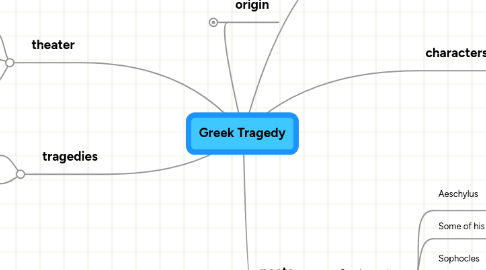
1. origin
1.1. no one knows the actual origin, but there are theories
1.2. Aristotle and a number of other writers proposed theories of how tragedy and comedy developed
1.3. said to have started started with the singing of a choral lyric also called the dithyramb in honor of Dionysus.
1.4. The traditions of Greek tragedy said the playwright Aeschylus added a second actor and Sophocles added a third.
2. tragedies
2.1. basic information
2.1.1. the poets would write a trilogy of three tragedies and then an additional unrelated comic piece called a satyr play to finish with
2.1.2. the basic background was from the chorus
2.1.3. most of the peoples problems were brought on by the Gods or higher powers
2.1.4. showed the stress and vulnerabilities of the Greek people
2.1.5. when Americans read tragedies, it is a translation of the original text and we miss many aspects of the plays
2.1.6. they were largely sung
2.1.7. "tragedy" refers to "tragic drama"
2.2. Agamemnon by Aeschylus
3. theater
3.1. importance of theater
3.1.1. it was a social, religious and civic gathering
3.1.2. theater was open to all people, including women
3.1.3. since it had to do with religion, they often were placed near or in sanctuaries
3.2. layout of the theaer
3.2.1. outside
3.2.2. people sat in a semicircle on wooden or stone seats engraved into a hillside called the theatron
3.2.3. look down on a somewhat circular flat area called the orchestra
3.2.4. side entrances called eisodi that led into the orchestra for different characters to enter and exit.
3.2.5. across from audience there was a raised platform which was backed by a building with central and side doors called the skene.
3.2.5.1. most of the action of the play took place on the raised platform with the skene acting as a backdrop and a changing room for the actors.
3.2.6. when trilogies and satyr plays were preformed, they lasted most of the day
3.3. famous theaters
3.3.1. Theater of Argos
3.3.1.1. in Argolid
3.3.1.1.1. built in the 4th century BC
3.3.2. Theater of Corinth
3.3.2.1. in Corinth
3.3.2.1.1. built by Emperor Hadrian
3.3.3. Theater of Sparta
3.3.3.1. in Laconia
3.3.3.1.1. very little has survived
3.3.4. Theater of Cassope
3.3.4.1. in Preveza
3.3.4.1.1. built at the northwest edge of the city on a rocky hillside
4. poets
4.1. 3 major poets
4.1.1. Aeschylus
4.1.2. Some of his famous works
4.1.2.1. Agamemnon
4.1.2.2. The Suppliants
4.1.2.3. The Persians
4.1.2.4. Prometheus Bound
4.1.2.5. Seven Against Thebes
4.1.2.6. Orestia
4.1.3. Sophocles
4.1.4. Some of his famous works
4.1.4.1. Oedipus the King
4.1.4.2. Oedipus at Colonus
4.1.4.3. Antigone
4.1.4.4. The Women of Treus
4.1.5. Euripides
4.1.6. Some of his famous works
4.1.6.1. Hippolytus and The Baccahe
4.1.6.2. Madea
4.1.6.3. Iphigenia at Aulis
4.1.6.4. Hecuba
4.1.6.5. Orestes
5. characters
5.1. all of the actors were male
5.1.1. male actors had to play female roles
5.2. there were actors, extras and chorus members (12 for tragedies) and they all wore full head masks made from either cork or molded mache
5.3. the only people who were unmasked were the oboe players
5.4. the central character was called a tragic protagonist
5.5. roles
5.5.1. rotagonist was the first actor
5.5.2. deuteragonist was the second actor
5.5.3. tritagonist `third actor'.
5.5.4. The protagonist had the main role while the other characters had lesser roles
5.6. along with acting, the actors sometimes had to sing songs solo, with the chorus or with other actors
5.7. costumes
5.7.1. gods, heroes and old men
5.7.1.1. wore a chiton
5.7.2. The latter
5.7.2.1. they wore an affron-colored garment which was rich with purple and gold people and stars. It was tied across the chest with a girdle made of dark purple, it had gold and jewels, and over it was a purple cloak
5.7.3. Goddesses and women of high rank
5.7.3.1. wore robes that were purple and gold
5.7.4. Matrons
5.7.4.1. wore incredibly embroidered cloth with some fastened on the head like a veil
5.7.5. queens and princesses
5.7.5.1. wore purple robes that hit the ground, was attached with golden stars
5.7.6. Warriors
5.7.6.1. wore a variety of armor, their helmets had plumes, and they wore a nicely embroidered mantle.
